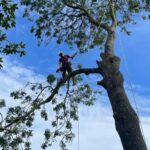Why Do Trees Fall Over In A Storm?
Maintaining and looking after your trees is vital for keeping them healthy, especially during stormy weather. Tree failure can lead to expensive property damage and even pose a risk to life. Knowing why trees fall over can help you identify the signs that a tree may be about to fail and put the necessary measures in place. So, why do trees fall over in a storm?
The high winds and increased rainfall of storms are often catalysts for tree failure. As the ground becomes saturated with rain, the tree roots are more likely to lose grounding and become compromised, and high winds cause the tree to topple over. Other factors that cause trees to fall in a storm are a heavy top, a weak root system, rotten roots, cracked trunks, missing bark, and broken/raised soil.
Read on to find out more about why trees fall over in a storm with Broadleaf Tree Surgery.
Emergency 24HR Tree Surgery Call Out Service
What Causes A Tree To Fall During A Storm?
There are several reasons for a tree to fall during a storm. Most healthy trees should be able to withstand harsh weather conditions, but there are occasions when the tree may collapse.
Saturated Soil
When the ground is saturated with heavy rain, it becomes softer, and tree roots are more likely to lose their hold. Heavy winds during a storm can then topple the tree as it has no anchor in the ground. Rainfall can also cause root decay in the long term due to excess moisture and lack of oxygen.
Heavy Tree Top
If the tree has become top-heavy due to a surge of sap/fluid that has been drawn up into the canopy, it causes a risk of collapse. Heavy winds can then cause the tree to fall due to the weight in the tree canopy.
Weakened Root System
If the tree’s natural growth pattern has been interfered with, and the tree doesn’t have a stable root system, this causes a high risk of the tree falling. If the roots are restricted or cut by roads, paths, or building foundations, the tree is more likely to collapse during a storm as it has no structure to support it.
Weakened/Damaged Tree
When a tree becomes damaged or the trunk splits, it will become weaker and more susceptible to falling during a storm. Damaged trees become brittle and lose their structural integrity, causing them to fall during high winds.
How Can You Tell If A Tree Will Fall?
Knowing the signs that your tree will fall is essential, especially if you live somewhere that experiences intense storms. Here are some clear warning signs that your tree may fall in stormy weather:
- Dead or falling branches: Dead or falling branches result from a lack of nutrition in the tree. These need to be removed immediately by a professional like us here at Broadleaf, as they can fall anytime.
- Roots near water: Trees near a body of water, such as a lake or pond, have the risk that their roots become waterlogged and begin to decay. This affects the tree’s structural integrity and increases the risk of falling.
- Missing bark or deep marks: An area where tree bark is missing, gashed or indented is called a “canker“. Cankers increase the risk of the tree breaking in that specific spot and structurally weaken the tree.
- Fungus on the roots: Fungus, such as mushrooms, near the base or roots of the tree is a sign that the roots are rotting or decaying. Root rot leads to weak root structure, and the tree is more likely to fall during stormy weather.
- Cracked or raised soil: The tree will need to be stabilised if you start to see broken or raised ground as the tree is uprooted. This makes the tree more likely to topple during a storm.
- Cracks in the trunk: If there is a large crack in the tree’s trunk, the tree is beginning to split. You will need to have the tree removed to prevent it from toppling and causing damage.
Which Trees Are Most Likely To Fall During A Storm?
Certain trees are more likely to fall during a storm than others, as they have a weaker structure and root system. The trees that are most likely to fall are:
- Conifers: Tall trees such as cedar, white spruce and pine are more susceptible to falling over during a storm. This is due to “windthrow“, the phenomenon of strong winds fully uprooting a tree.
- Evergreens: Evergreen trees, such as spruce, yew, and fir, are more likely to fall during a storm. This is because evergreen trees keep their leaves year-round and can become saturated in the rain. This makes them top-heavy and more susceptible to toppling.
- Older Deciduous Trees: Older deciduous trees, such as willow, are likelier to fall during storms. Willow trees often have shallow roots, making them more vulnerable to wind-throwing during storms.
How To Prepare Trees For Stormy Weather?
If you are worried about the risk of your tree falling during a storm, there are some ways you can prepare. Preparing will help to keep your home and garden safe from any damage caused by your trees.
Pruning
Regularly pruning your trees can help improve the structure and health of your trees. Removing branches overhanging your buildings, other structures, and cables can help prevent damage to your property. Pruning can also reduce the risk of deadwood as you are promoting growth. To find out more, check out our post on pruning.
Deadwood Removal
Deadwood removal can help reduce the risk of damage to your home and garden during a storm. By removing dead branches, you prevent them from falling at a later date and causing property damage. Broadleaf Tree Surgery offers a deadwood removal service to help keep your property and trees safe during stormy/winter weather.
Non-Evasive Bracing
You can opt for non-evasive bracing if your tree has begun to split or lean in a specific direction. This will prevent the tree from collapsing, provide support to the tree, and help you to avoid cutting down your tree. At Broadleaf, we offer non-evasive bracing as one of our services and can help protect your tree during winter weather.
Tree Removal
If you are worried about the health or condition of your tree and the risk it poses, you can have your tree removed. This will remove the hazard your tree presents to your property and will cost less than paying for any damage the tree falling may cause to your home or garden. If you need your trees removed, check out our tree removal service.
Professional Tree Surgery With Broadleaf Tree Surgery
If you need help preparing your trees for the stormy weather or are looking for a specific service, why not get in touch with us today? We offer a free consultation to give you the best advice for your trees.
Alternatively, if you are looking for specific care for your trees, why not browse our service page to find out what we can do for you?



